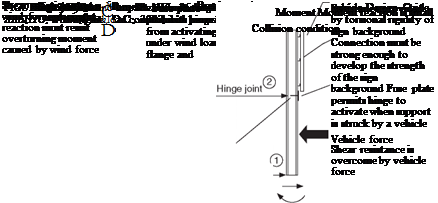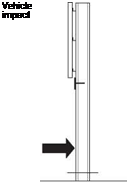Sign Supports
Roadway signs include overhead signs, large roadside signs (area over 50 ft2 or 5 m2), and small roadside signs.
Overhead signs include sign bridges and cantilevered signs. Their supports are generally too large to adapt to a breakaway design. When possible, install overhead signs on existing bridges or other structures. Otherwise, supports within the clear zone should be shielded with a traffic barrier.
Large roadside signs typically have two or more supports, each of which is of the breakaway type. Figures 6.9 and 6.10 show the loading conditions and the breakaway features.
 |
Note the hinge joint with fuse plate just below the sign and the breakaway base (shear
plate). The supports must resist ice and wind loads and also meet the following criteria:
• The hinge must be at least 7 ft (2.1 m) above ground to prevent windshield penetration.
• A single post 7 ft (2.1 m) or more from another post should have a mass less than 45 lb/ft (65 kg/m); total mass below the hinge but above the shear plate should not exceed 600 lb (270 kg). Two posts spaced less than 7 ft (2.1 m) apart should have a mass less than 18 lb/ft (27 kg/m).
•
 |
 |
 |
|
Supplementary signs should generally not be placed below the hinges.
FIGURE 6.10 Impact performance of large roadside sign. (From Roadside Design Guide, AASHTO, Washington, D. C., 2002 and 2006, with permission)
Breakaway mechanisms for large sign supports may be either a fracture or a slip – base type. The fracture type includes couplers that fracture, or in the case of wood posts, simply posts with reduced cross-sections. Slip-base-type mechanisms activate when two parallel plates slide apart as bolts are pushed out under impact. As shown in Fig. 6.11, the designs may be of the unidirectional or multidirectional type. The upper hinge design includes a saw cut through the front flange and web of the plate, and a fuse plate on the front flange (impact side). The fuse plate has slotted bolt holes, and the bolts must be torqued to specified values for proper functioning. Alternatively, the fuse plate may have a line of open holes at the cut line, with the plate designed to rupture at the required load, negating the need for the specific values of bolt torque. Even with the breakaway design feature, it is good practice to locate large signs outside the clear zone where feasible.
Small roadside signs may be driven directly into the soil, set in drilled earth holes, or mounted on a base. U-shaped steel posts driven into the ground can generally bend and yield at the base without special devices. Splicing the posts is not usually recommended, because performance is not predictable. Wood posts set in drilled holes can fracture at the base, as well as steel pipes connected to anchors driven into the ground. Also, small sign supports may be mounted on fracture bases or slip bases of the unidirectional or multidirectional type. A typical unidirectional design uses a four-bolt slotted slip base, inclined in the direction of traffic by 10° to 20°. This angle allows the sign to move up so the impacting vehicle can pass underneath. A hinge in the top of the post is not needed. Multidirectional bases are usually triangular and release when struck in any direction. They are often used in medians and at ends of ramps and similar locations. Because torque requirements for slip base bolts are low, wind vibrations have caused supports to “walk” from the slots under wind vibrations, but this can be prevented by using a sheet metal keeper plate. Overtorquing must be prevented, because this causes high friction between the slip base elements and prevents the support from releasing as intended.






Leave a reply